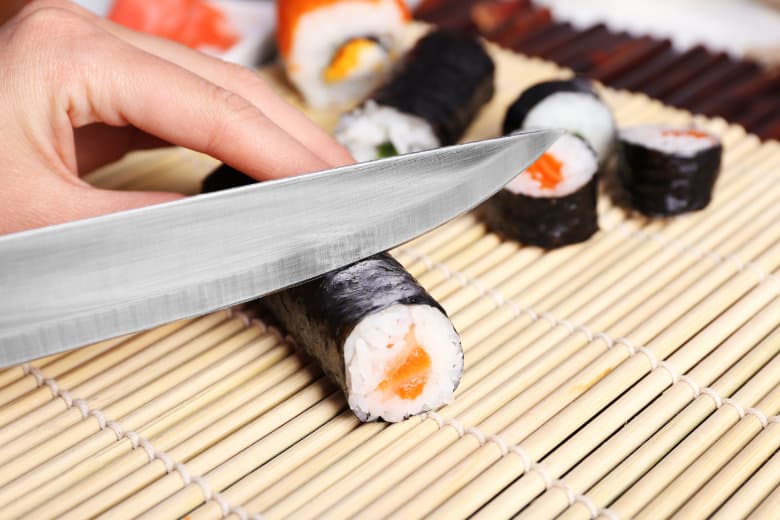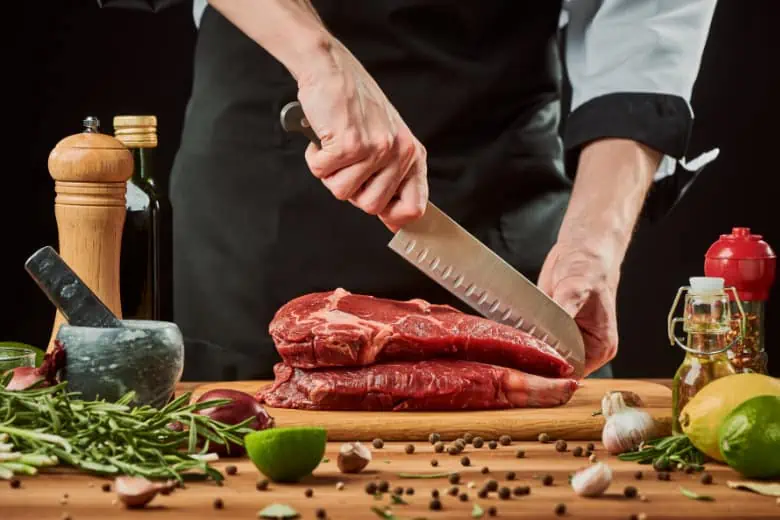As a home cook, I often find myself using various knives in my kitchen to chop, slice, and dice ingredients. Two popular types of knives that many cooks use are the santoku and the gyuto. These Japanese knives have become known for their incredible versatility in the kitchen, but do you need both?
The santoku knife, which translates to “three virtues” or “three uses,” is designed for slicing, dicing, and mincing. Its shorter, wider blade makes it ideal for precision tasks and navigating smaller ingredients. On the other hand, the gyuto, often referred to as the Japanese chef’s knife, is a multi-purpose knife with a longer, narrower blade that is versatile enough to handle a variety of tasks as well. The key difference between the santoku and gyuto lies in the shape and size of their blades.
When choosing between a santoku and a gyuto, it’s essential to consider factors such as the type of ingredients you frequently work with, the size of your cutting board, and your personal cutting technique and comfort. Both knives require proper maintenance and sharpening to ensure they remain as effective and sharp as possible over time, which is another aspect to keep in mind.
With these factors in mind, I have researched and tested various santoku and gyuto knives to help you determine which type of knife best suits your needs and optimizes your culinary experience in the kitchen.

Santoku vs Gyuto: Top Picks
In this section, I have curated a list of the best santoku and gyuto knives available on Amazon to help you decide which one is perfect for your cooking style.
Mercer Culinary Asian Collection Santoku Knife 7-Inch
As someone who has used this Mercer Culinary Asian Collection Santoku Knife, I can confidently say that one of its most noteworthy features is the razor-sharp, high-carbon German steel blade. This blade is not only stain-free, but it also resists rust, corrosion, and discoloration, making it perfect for long-term use in the kitchen.
Another aspect of this knife that I appreciate is the double-edge blade with a 16° edge on both sides. This design allows for precision cutting and offers a fine stone finish, which is something I find quite valuable in any good kitchen knife.
However, I noticed that the steel used for the blade can be quite brittle, which means it may not withstand heavy-duty chopping tasks very well. Additionally, the handle, while slip-resistant and made from Santoprene, may not be the most comfortable for prolonged use.
While this knife has its pros and cons, overall, it has performed quite well in my kitchen. Its razor-sharp blade and slip-resistant handle make it a worthy addition to any collection. Keep in mind that it may not be suitable for heavy-duty tasks, so consider your needs before purchasing it. At a fraction of the price of the Shun (see below), I can understand why it’s such a popular knife.
Pros
Cons
Imarku 7-Inch Santoku Knife
The Imarku 7-inch Santoku Knife is a fantastic addition to any kitchen, offering superior sharpness and versatility at a great price.
I recently had the pleasure of using the Imarku 7 Inch Santoku Knife in my kitchen, and I must say it was pretty impressive for a budget-priced product. The German HC stainless steel blade is incredibly sharp, allowing for precise cuts and effortless slicing, but the hollow edge design was, for the most part, ineffective.
The ergonomic Pakkawood handle fits comfortably in my hand and provided a secure, comfortable grip that minimized wrist tension, making the knife easy to maneuver and control. Furthermore, the knife’s beautiful design and high-quality black gift box make it an excellent present for friends and family who enjoy cooking.
However, there are a few other drawbacks to take note of. The knife is not dishwasher safe and requires hand washing and proper care to maintain its sharpness. Due to its extreme sharpness, one must be cautious when using and storing the knife to avoid accidents and nicks. Also, the edge may require more frequent sharpening compared to some other knives to maintain its peak performance, but, for the money, it’s hard to resist.
Overall, the Imarku 7 Inch Santoku Knife is an excellent investment for upgrading your cooking experience and would make for a great gift for the chef in your life.
Pros
Cons
Best Santoku: Shun Kanso Santoku 7 Inch Hollow Ground Knife
Anyone familiar with quality Japanese kitchen knives knows the name Shun.
Using the Shun Kanso Santoku 7 Inch Hollow Ground Knife has been a truly enjoyable experience for me. The Asian-inspired design combined with the hollow-ground indentations allows the knife to glide smoothly through various foods, making the cutting process more efficient. With just the right amount of belly curve, rocking cuts were comfortable and easy to execute.
Constructed with AUS10A high-carbon stainless steel and reinforced with Vanadium, the knife is strong, corrosion-resistant, and wear-resistant. The razor-sharp 16-degree edge has proven to maintain its sharpness with regular maintenance. However, the delicate nature of the blade could be an issue if not handled with care.
The full-tang handle is made of beautiful contoured tagayasan wood, known as “iron sword wood,” offering a secure grip, excellent control, and precision balance. While the handle is aesthetically pleasing, it may feel rough to some users. It is worth noting that with proper maintenance and care, this knife will last a long time and provide impressive performance in the kitchen.
In conclusion, the Shun Kanso Santoku 7 Inch Hollow Ground Knife is a well-crafted and versatile kitchen tool that delivers remarkable cutting results. While it may not be the best choice for those who tend to be rough on their knives, those who appreciate a delicate and well-balanced blade will truly enjoy using this knife.
Pros
Cons
Yoshihiro VG10 16 Layer Hammered Damascus 8-Inch Gyuto Knife
This high-quality chef’s knife is worth the investment for its beauty, performance, and versatility.
When I used the Yoshihiro VG10 16 Layer Hammered Damascus Gyuto Knife recently, and I must say it left quite an impression on me. As a Japanese chef’s knife, the gyuto model offers a wide range of utility for different ingredients, from chopping fresh produce to carving proteins such as fish and meat.
Right off the bat, I noticed how sharp this knife was. The performance it delivers justifies the price tag, making every cutting task feel effortless. The curved blade allows for smooth rocking and fast chopping, which makes meal preparations easier and more enjoyable.
However, the Yoshihiro Gyuto is another knife that requires special care and maintenance to keep its sharpness and beauty intact. Sharpening should only be done with water whetstones, and the knife should be hand washed and dried immediately to avoid potential damage from acidic ingredients. While the knife is perfect for slicing, dicing, and chopping, it’s not suitable for hard or frozen foods and can potentially lead to damaging the delicate blade.
Despite these minor drawbacks, the Yoshihiro VG10 16 Layer Hammered Damascus Gyuto Knife is truly a work of art. The hammered steel blade mimics the appearance of traditional Damascus knives, adding character and beauty to your kitchen lineup. This knife would be a great addition for those who prioritize performance and aesthetics but be prepared to invest some time and resources into its maintenance.
Pros
Cons
Shun Cutlery Sora Chef’s Knife 8”
I have been using the Shun Cutlery Sora Chef’s Knife for quite some time, and it quickly became my go-to option for everything from slicing filet to mincing garlic. The Japanese gyuto-style blade allows me to efficiently cut more food with each slice, and the San Mai construction ensures the knife remains razor-sharp.
Using the Sora has been really enjoyable, not only for its performance but it just felt “right.” Made from a textured polymer, the handle offered a secure grip and felt well-balanced in my hand. However, some may find the handle material to lack the premium feel of other knives on the market.
One thing to note when using the Shun Sora Chef’s Knife is the need for careful maintenance. It’s important to avoid cutting through bones or applying unnecessary pressure as it could potentially damage the delicate blade. Additionally, proper cleaning and sharpening habits are essential to keep the knife in top-notch condition.
The Shun Cutlery Sora Chef’s Knife is a fantastic choice and one of my personal favs.
Pros
Cons
Best Gyuto: Tojiro DP Gyutou 8.2-Inch
I’ve been using the Tojiro DP Gyutou for quite some time, I can confidently say that it exceeded my expectations. The knife’s 8.2-inch blade, made from cobalt alloy steel, is incredibly sharp right out of the box. Its stain resistance, and ease of maintenance make it a joy to work with in the kitchen, especially when dealing with various ingredients.
The reinforced, laminated handle feels comfortable in my hand and provides excellent balance. It is designed for both left and right-handed users, making it versatile for any cook. However, it’s essential to hand wash this knife, as it’s not dishwasher safe, but honestly, that’s a small price to pay for such a fantastic chef’s knife.
One thing to keep in mind when using the Tojiro DP Gyutou is that it requires proper technique for optimal edge retention. Using a slicing motion instead of chopping will help maintain the sharpness of the blade, preventing it from dulling too quickly. The stainless steel blade is more durable than most.
Overall, I am genuinely impressed with the performance of the Tojiro DP Gyutou and would highly recommend it to anyone looking to level up their culinary skills with a reliable, high-quality chef’s knife. With proper care and technique, this knife will surely be a valuable addition to your kitchen arsenal.
Pros
Cons
Related: Best Japanese Knives For Your Kitchen. A Buyer’s Guide
Buying Guide
When searching for the perfect knife, it’s crucial to determine the type of tasks you’ll be performing in the kitchen. Santoku and gyuto knives have their unique advantages, making the selection process essential. In this buying guide, I’ll go over a few factors to consider when choosing between these two knife types.

Size and Weight
The size and weight of the knife can affect how comfortable you’ll feel when using it for extended periods. Typically, santoku knives have a shorter blade length, around 5 to 7 inches, making them lightweight and easy to maneuver. Gyuto knives usually have longer blades, around 8 to 12 inches, and may be heavier, providing more power for cutting through dense ingredients. It’s essential to select a knife that feels comfortable and well-balanced in your hand.
Blade Shape
Santoku and gyuto knives vary in their blade shapes. Santoku knives have a flatter edge, suitable for up-and-down chopping motions, while gyuto knives have a curved blade allowing for a rock-chopping motion and is very similar to a Western Chefs knife. If you need a versatile knife for rocking and slicing, the gyuto might be a better option. However, if you prefer a more straightforward chopping style, the santoku may be ideal. Both styles offer plenty of versatility.
Steel Type
The type of steel used in the knife blade can impact its sharpness, durability, and resistance to corrosion. High-carbon stainless steel is a popular choice for its balance of sharpness and corrosion resistance. There are also different types of Japanese steel, such as VG-10, that provide excellent edge retention. You’ll want to choose a knife with a steel type that combines durability, performance, and easy maintenance.
Price
When selecting a knife, it’s crucial to consider your budget and find a product that offers the best value for the price. High-quality knives may initially be more expensive, but they typically last longer and perform better than cheaper alternatives.
In conclusion, when deciding between a santoku and a gyuto knife, examine your kitchen’s needs and preferences. The size, weight, blade shape, steel type, and price are all essential factors to consider when making this crucial investment in my culinary journey.

Frequently Asked Questions
What is the main difference between Santoku and Gyuto knives?
The main difference between santoku and gyuto knives lies in their shape and purpose. A santoku is a Japanese knife with a flatter, wider blade coupled with a gentle curve towards the tip, while a gyuto knife has a narrower, more curved blade with a pointed tip. Santoku knives are designed for precise slicing, dicing, and mincing, whereas gyuto knives are versatile and used for various cutting tasks, including slicing, dicing, and chopping.
When should I choose a Santoku over a Gyuto?
Choose a santoku knife over a gyuto when you want more control and precision in your cutting tasks. Santoku knives are perfect for delicate tasks such as slicing paper-thin vegetables or finely dicing herbs. Their flat blade allows for better contact with the cutting board, helping you achieve more accurate cuts.
Which knife is more versatile: Santoku or Gyuto?
In terms of versatility, I would say the gyuto knife is more versatile than the santoku. With its curve and pointed tip, the gyuto is suitable for a variety of cutting tasks, from slicing and dicing to chopping and mincing. The santoku, on the other hand, excels in precise cutting tasks but might not be suitable for all purposes.
Are Gyuto knives more expensive than Santoku knives?
The price of both gyuto and santoku knives can vary greatly depending on the brand, materials used, and craftsmanship. In general, you may find that gyuto knives tend to be more expensive than santoku knives, but this is not always the case. It is important to focus on the quality and features of each knife rather than just the price.
Which knife is better for a beginner: Santoku or Gyuto?
For a beginner, I would recommend the santoku knife. With its flatter and wider blade, it allows for better contact with the cutting board, making it easier to achieve accurate and consistent cuts. Additionally, since santoku knives are designed for precise cutting tasks, they can help beginners develop good knife skills.
Do professional chefs prefer Santoku or Gyuto knives?
Professional chefs may have preferences based on their experience, tasks, and personal preferences. Some might prefer the versatility of the gyuto knife, while others might choose the santoku knife for its precision in cutting tasks. Ultimately, it comes down to each chef’s specific needs and requirements when selecting their preferred knife. Many chefs have both.
Related: Kitchen Knife Buyer’s Guide: Tips For The Perfect Choice
Conclusion
In my experience, both santoku and gyuto knives offer excellent performance in the kitchen. However, there are key differences between the two that are worth considering when choosing one for your cooking needs.
The santoku knife, with its all-purpose functionality and shorter, wider blade, is an ideal option for those who primarily chop, slice, and dice vegetables and fruits. Its sheep’s foot tip and Granton edge promote easier cutting and reduce food sticking to the blade. In my opinion, the santoku of choice would be the Shun Kanso Santoku 7 Inch Hollow Ground Knife.
On the other hand, the gyuto knife possesses a longer, thinner blade, making it suitable for cutting larger or tough ingredients like meat and fish. It’s pointed tip and curved edge allow for more precise cuts and professional slicing techniques. My favorite is the Tojiro DP Gyutou.
In terms of control, you might find that the santoku knife’s balance feels more comfortable if you have smaller hands or prefer a lighter feel. Conversely, the gyuto knife is better suited for those with larger hands or who prefer a more substantial, sturdy grip while cutting.
As a final note, always remember to maintain and sharpen your Japanese kitchen knives regularly, regardless of whether you choose a santoku or gyuto. Proper care will greatly extend the life and usefulness of your chosen tool in the kitchen.






